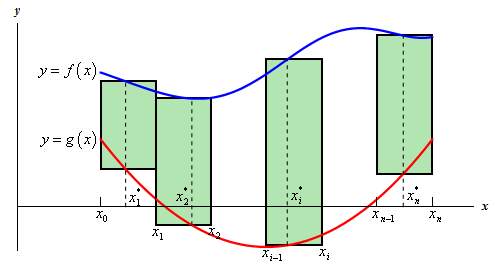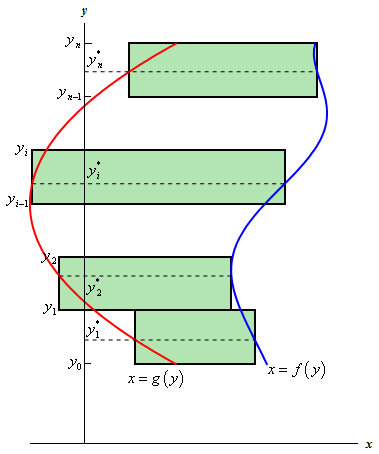Area between Two Curves
We'll start with the formula for finding the area among y = f(x) and y = g(x) on the interval [a,b]. We will also suppose that f(x) ≥ g(x) on [a,b].
Now we will precede much as we did while we looked that the Area Problem in the Integrals section. We will initially divide up the interval in n equal subintervals all with length,
Δx = (b -a)/n
After that, pick a point in all subinterval, xi*, and we can then use rectangles on each interval as given here,

The height of each of these rectangles is specified by,
f(xi*) - g(xi*)
and then the area of each rectangle is,
(f(xi*) - g(xi*)) Δx
Therefore, the area in between the two curves here is,
A ≈  (f(xi*) - g(xi*)) Δx
(f(xi*) - g(xi*)) Δx
So exact area is,
A ≈limn→∞  (f(xi*) - g(xi*)) Δx
(f(xi*) - g(xi*)) Δx
Then, recalling the definition of the definite integral it is nothing more than,
A = a∫b f(x) - g(x) dx
The formula beyond will work given the two functions are in the form y = f(x) and y = g(x). Though, not all functions are in this form. At times we will be forced to work along with functions in the form among x = f(y) and x = g(y) on the interval [c,d] (an interval of y values...)
While this happens the derivation is the same Firstly we will begin by assuming that f(y) ≥ g(y) on [c,d]. We can after that divide up the interval in equal subintervals and build rectangles on each of such intervals. Now there is a sketch of above situation.

Subsequent the work from above, we'll arrive at the subsequent for the area,
A = c∫d f(y) - g(y) dy
Therefore, regardless of the form such the functions are in we use fundamentally similar formula.